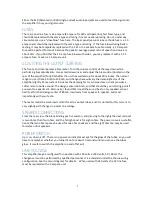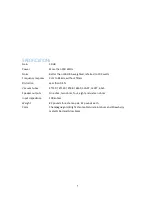
2
Either the XLR (balanced) or RCA (single-ended) audio input jacks are used to feed the signal into
the amplifier from your signal source.
FUSES
The rear panel line fuse is a 6 ampere (3 ampere for 240 volt operation), fast blow type, and
should be replaced with the same type and rating if it ever needs replacing. Do not,
under any
circumstances
, use a "slow-blow" fuse here. The (rear panel) vacuum tube cathode fuse is a 1.0
ampere and should be replaced with the same type and rating. If the fuse blows during bench
testing, it may be
temporarily
replaced with a 1.25 or 1.5 ampere fuse. Normally, a 1.0 ampere
fuse will be perfect for music because the peak-to-average power ratio of speech and music is
about 10:1. If you find that the 1.0 amp fuse blows with music, you may replace it with a 1.25
ampere fuse, or even a 1.5 ampere unit.
ADJUSTING THE OUTPUT TUBE BIAS
The front panel incorporates a bias meter. Turn the volume control all the way down while
performing bias adjustments. Use a small screwdriver and adjust the bias control (located on the
rear of the amplifier) for 80 mA after the unit has warmed up for about 20 minutes. The normal
range to use is from 60 mA to 150 mA, and changes here will vary the damping factor of the
amplifier slightly. More current increases the damping factor, whereas less current provides a
softer more tube-like sound. The design center is 80 mA, and that should be your starting point if
you want to experiment. Personally, I found that I loved the sound best on my speakers when I
had it set for their design center of 80 mA. It will vary from speaker to speaker, and most
importantly with your taste.
The meter reads the combined current for all six output tubes, and it is normal for this current to
vary slightly with changes in power line voltage.
SPEAKER CONNECTIONS
From the rear view: the black binding post is common, and (moving to the right) the next red post
is two ohms, then four ohms, and the far right post is for eight ohms. The power curve is quite flat,
hence the two ohm tap may be used for one ohm speakers, and the eight ohm tap may be used
for sixteen ohm speakers.
POWER SWITCH
Up is on, down is off. There is no power-on indicator except for the glow of the tubes, so you will
have to remember whether you turned it on for about 10 seconds until you can see the tubes
glow. It is safe to switch the amplifier on and off at will.
LINE VOLTAGE
This amplifier may be configured for operation with 120 volts or 240 volts, 50 / 60 Hz. The
changeover must be performed by qualified personnel. It is a standard under the chassis wiring
configuration. See the circuit diagram for details. When used with 240 volts, the AC line fuse
must be replaced with a 3 ampere unit.






